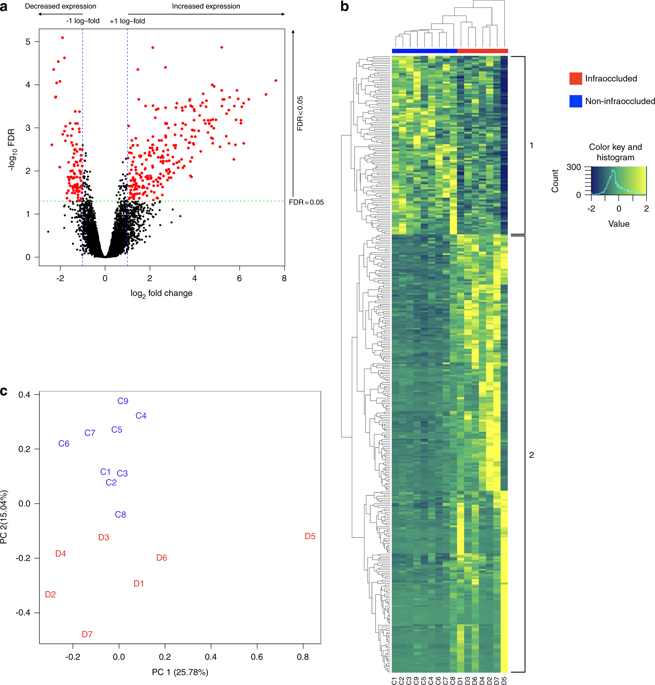当前位置:
X-MOL 学术
›
Int. J. Oral Sci.
›
论文详情
Our official English website, www.x-mol.net, welcomes your
feedback! (Note: you will need to create a separate account there.)
Transcriptome analysis of ankylosed primary molars with infraocclusion.
International Journal of Oral Science ( IF 10.8 ) Pub Date : 2020-02-21 , DOI: 10.1038/s41368-019-0070-1 Annie Tong 1 , Yuh-Lit Chow 2 , Katie Xu 1 , Rita Hardiman 1 , Paul Schneider 1 , Seong-Seng Tan 2
International Journal of Oral Science ( IF 10.8 ) Pub Date : 2020-02-21 , DOI: 10.1038/s41368-019-0070-1 Annie Tong 1 , Yuh-Lit Chow 2 , Katie Xu 1 , Rita Hardiman 1 , Paul Schneider 1 , Seong-Seng Tan 2
Affiliation

|
Primary molar ankylosis with infraocclusion can retard dental arch development and cause dental asymmetry. Despite its widespread prevalence, little is known about its molecular etiology and pathogenesis. To address this, RNA sequencing was used to generate transcriptomes of furcal bone from infraoccluded (n = 7) and non-infraoccluded (n = 9) primary second molars, all without succeeding biscuspids. Of the 18 529 expressed genes, 432 (2.3%) genes were differentially expressed between the two groups (false discovery rate < 0.05). Hierarchical clustering and principal component analysis showed clear separation in gene expression between infraoccluded and non-infraoccluded samples. Pathway analyses indicated that molar ankylosis is associated with the expression of genes consistent with the cellular inflammatory response and epithelial cell turnover. Independent validation using six expressed genes by immunohistochemical analysis demonstrated that the corresponding proteins are strongly expressed in the developing molar tooth germ, in particular the dental follicle and inner enamel epithelium. The descendants of these structures include the periodontal ligament, cementum, bone and epithelial rests of Malassez; tissues that are central to the ankylotic process. We therefore propose that ankylosis involves an increased inflammatory response associated with disruptions to the developmental remnants of the dental follicle and epithelial rests of Malassez.
中文翻译:

下颌骨强直磨牙的转录组分析。
原发性磨牙强直与咬合不足会延迟牙弓的发育并引起牙齿不对称。尽管其广泛流行,但对其分子病因和发病机理知之甚少。为了解决这个问题,使用RNA测序从次咬合的次牙(n = 7)和非次咬合的n(9 = 9)的牙槽骨中产生转录组。在18 529个表达的基因中,两组之间有432个(2.3%)基因差异表达(假发现率<0.05)。层次聚类和主成分分析表明,在封闭和未封闭样本之间基因表达明显分离。通路分析表明,臼齿强直与基因表达相关,该基因与细胞炎症反应和上皮细胞更新一致。通过免疫组织化学分析使用六个表达的基因进行的独立验证表明,相应的蛋白质在正在发育的磨牙齿胚中,尤其是在牙囊和内釉上皮中强烈表达。这些结构的后代包括Malassez的牙周膜,牙骨质,骨骼和上皮细胞。对强直过程至关重要的组织。因此,我们提出,强直涉及涉及炎性反应的增加,与炎症反应的破坏有关,该破坏与牙囊的发育残余和Malassez的上皮休息有关。通过免疫组织化学分析使用六个表达的基因进行的独立验证表明,相应的蛋白质在正在发育的磨牙齿胚中,尤其是在牙囊和内釉上皮中强烈表达。这些结构的后代包括Malassez的牙周膜,牙骨质,骨骼和上皮细胞。对强直过程至关重要的组织。因此,我们提出,强直涉及涉及炎性反应的增加,与炎症反应的破坏有关,该破坏与牙囊的发育残余和Malassez的上皮休息有关。通过免疫组织化学分析使用六个表达的基因进行的独立验证表明,相应的蛋白质在正在发育的磨牙齿胚中,尤其是在牙囊和内釉上皮中强烈表达。这些结构的后代包括Malassez的牙周膜,牙骨质,骨骼和上皮细胞。对强直过程至关重要的组织。因此,我们提出,强直涉及涉及炎性反应的增加,与炎症反应的破坏有关,该破坏与牙囊的发育残余和Malassez的上皮休息有关。马拉塞兹的牙骨质,骨骼和上皮细胞 对强直过程至关重要的组织。因此,我们提出强直涉及涉及炎性反应的增加,该炎性反应与对马拉塞兹的牙囊和上皮休息的发育残余的破坏有关。马拉塞兹的牙骨质,骨骼和上皮细胞 对强直过程至关重要的组织。因此,我们提出,强直涉及涉及炎性反应的增加,与炎症反应的破坏有关,该破坏与牙囊的发育残余和Malassez的上皮休息有关。
更新日期:2020-02-21
中文翻译:

下颌骨强直磨牙的转录组分析。
原发性磨牙强直与咬合不足会延迟牙弓的发育并引起牙齿不对称。尽管其广泛流行,但对其分子病因和发病机理知之甚少。为了解决这个问题,使用RNA测序从次咬合的次牙(n = 7)和非次咬合的n(9 = 9)的牙槽骨中产生转录组。在18 529个表达的基因中,两组之间有432个(2.3%)基因差异表达(假发现率<0.05)。层次聚类和主成分分析表明,在封闭和未封闭样本之间基因表达明显分离。通路分析表明,臼齿强直与基因表达相关,该基因与细胞炎症反应和上皮细胞更新一致。通过免疫组织化学分析使用六个表达的基因进行的独立验证表明,相应的蛋白质在正在发育的磨牙齿胚中,尤其是在牙囊和内釉上皮中强烈表达。这些结构的后代包括Malassez的牙周膜,牙骨质,骨骼和上皮细胞。对强直过程至关重要的组织。因此,我们提出,强直涉及涉及炎性反应的增加,与炎症反应的破坏有关,该破坏与牙囊的发育残余和Malassez的上皮休息有关。通过免疫组织化学分析使用六个表达的基因进行的独立验证表明,相应的蛋白质在正在发育的磨牙齿胚中,尤其是在牙囊和内釉上皮中强烈表达。这些结构的后代包括Malassez的牙周膜,牙骨质,骨骼和上皮细胞。对强直过程至关重要的组织。因此,我们提出,强直涉及涉及炎性反应的增加,与炎症反应的破坏有关,该破坏与牙囊的发育残余和Malassez的上皮休息有关。通过免疫组织化学分析使用六个表达的基因进行的独立验证表明,相应的蛋白质在正在发育的磨牙齿胚中,尤其是在牙囊和内釉上皮中强烈表达。这些结构的后代包括Malassez的牙周膜,牙骨质,骨骼和上皮细胞。对强直过程至关重要的组织。因此,我们提出,强直涉及涉及炎性反应的增加,与炎症反应的破坏有关,该破坏与牙囊的发育残余和Malassez的上皮休息有关。马拉塞兹的牙骨质,骨骼和上皮细胞 对强直过程至关重要的组织。因此,我们提出强直涉及涉及炎性反应的增加,该炎性反应与对马拉塞兹的牙囊和上皮休息的发育残余的破坏有关。马拉塞兹的牙骨质,骨骼和上皮细胞 对强直过程至关重要的组织。因此,我们提出,强直涉及涉及炎性反应的增加,与炎症反应的破坏有关,该破坏与牙囊的发育残余和Malassez的上皮休息有关。











































 京公网安备 11010802027423号
京公网安备 11010802027423号